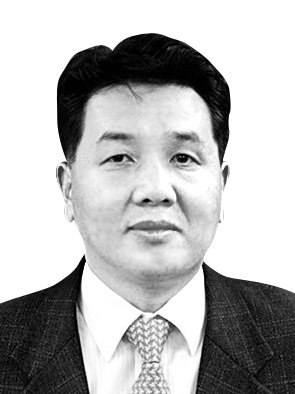Saemangeum redux

The author is the deputy social news editor of the JoongAng Ilbo.
Korea has a checkered history with the Saemangeum development project and plans to construct a new airport in the Yeongnam region, which comprises Busan, Daegu, and North and South Gyeongsang provinces. They are both hot-potato issues during every election season, from the presidential race all the way down to the local elections. The Saemangeum development project goes back 33 years ever since former President Roh Tae-woo made it his election pledge in 1987. Construction on the world’s longest 34-kilometer (21-mile) Saemangeum dyke began in 1991. The plan for a new airport in Yeongnam goes back 14 years since 2006, when former President Roh Moo-hyun ordered a consideration of it, or 13 years since 2007, when Roh’s successor Lee Myung-bak made it his election pledge.
In February 1997, I had a chance to visit the Saemangeum development site in North Jeolla on the country’s southwest coast, as people began to ask serious questions about the initiative’s environment pollution and genuine necessity. I remember dump trucks loaded with heavy rocks and dirt leaving behind a long trail of dust as they built up the dyke. To this day, over 7 trillion won ($6.3 billion) has been spent on building the sea dyke, yet Saemangeum still remains a land of the future.
On Nov. 24, Prime Minister Chung Sye-kyun, Land Minister Kim Hyun-mee and North Jeolla Gov. Song Ha-jin attended a ceremony marking the opening of the Saemangeum East-West Road, a four-lane pathway stretched across 20.4 kilometers between the Saemangeum sea dyke and Jinbong-myeon in Gimje, North Jeolla. The government touted the road as the first key infrastructure for the project, or turning the area reclaimed from the dyke into an industrial hub. The project, however, has a long way to go for it to become “the land of gold” that the Moon Jae-in administration promised. Of the 291 square kilometers (71,908 acres) of area up for reclamation, the government should fill up 73 percent by the end of 2020, but only 40 percent has been filled or is being filled.
Recent talks about building a new airport on Busan’s Gadeok Island resemble the Saemangeum project in many ways. Just five months before the April 15 Busan mayoral by-election, the Moon administration is trying to win votes by luring constituents with a massive construction project on the grounds of “balanced development,” while barely mentioning anything about the colossal budget needed. The ruling Democratic Party (DP) and some lawmakers of the main opposition People Power Party (PPP) representing Busan, Ulsan and South Gyeongsang have been pressing ahead with the Gadeok airport construction plan ever since a government committee of experts earlier this month mentioned the need to “fundamentally review” the original plan to expand the Gimhae International Airport in South Gyeongsang. Many critics raised their voices against a new airport on Gadeok Island, a project that would cost a whopping 10 trillion won and involve tearing down mountains and filling up parts of the sea. But the Moon administration does not seem to care.
DP Chairman Lee Nak-yon even raised the possibility of enacting a special law for constructing the Gadeok airport, essentially suggesting the initiative be carried out as quickly as possible without a pre-feasibility study. Had Lee truly cared about taxes, he could never have suggested a fast-track option for a 10-trillion-won project. Mandatory pre-feasibility studies was first introduced in 1999 to prevent the government from rushing to pour cash into programs like Saemangeum without a thorough analysis of economic effects, as well as how they contribute to regional development. The economic aspect is a core of the pre-feasibility study. The study is normally required for any projects worth more than 50 billion won in total construction cost and 30 billion won in state subsidies, except for those involving inter-Korean cooperation.
The government often cites the legendary success of the Gyeongbu Expressway when trying to placate critics of large-scale national projects, effectively incorporating the Decide-Announce-Defend approach to push through anything it sees fit. But not only does this sabotage public opinion-gathering processes, it also undermines indispensable pre-feasibility studies required for all large-scale national projects.
Pre-feasibility studies on countless state projects have concluded to be a waste of tax money. Exempting a 10-trillion-won project from that step is nothing but populism. Some say that an airport needs to be built on Gadeok Island for the sake of balanced development, but an airport can’t guarantee that. There are dozens of airports across the country operating at deficits. If the government is genuinely aiming for balanced development, there are a whole lot of other ways to achieve that, such as by creating so-called innovative cities, transferring public organizations to provinces and fostering each region’s main national university, known as “flagship national universities.”
If a new airport is absolutely needed on Gadeok Island, then it should be built. But what’s the hurry when spending 10 trillion won? A pre-feasibility study must come first — or else, the airport may end up like Saemangeum.










with the Korea JoongAng Daily
To write comments, please log in to one of the accounts.
Standards Board Policy (0/250자)